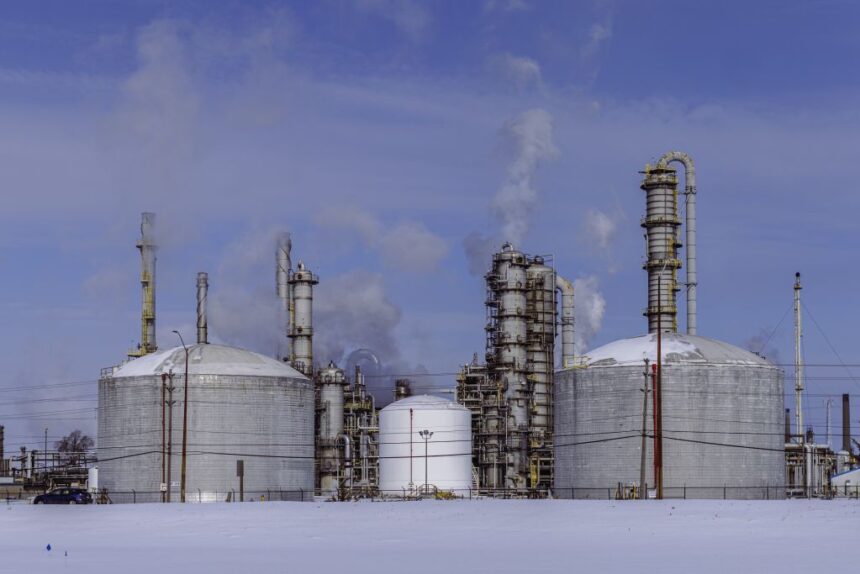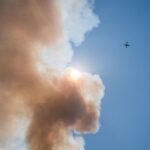There’s something in the air in Aamjiwnaang First Nation. The community is located next to an industrial area of Sarnia, Ont., known to many as Chemical Valley. There are dozens of factories and refineries here, accounting for 40 per cent of Canada’s chemical industry — and an enormous amount of air pollution. That pollution comes in many forms, but the levels of one chemical in particular caused Aamjiwnaang to declare a state of emergency last spring. Benzene is a byproduct of petroleum refining, used to make Styrofoam and other plastic materials. It’s also a volatile organic compound — a category of chemicals that evaporate easily into the air. Inhaling very high amounts can make you very sick, very quickly. And constantly breathing benzene-laden air, even in very small amounts, can do a lot of damage, too — notably by increasing your risk of leukemia and other cancers. Ontario’s Environment Ministry set emissions benchmarks much higher than those that triggered the state of emergency, which remains active to this day. A recent investigation by The Narwhal showed the province knew about the health risks this posed to the Aamjiwnaang community, and failed for years to take action that would meaningfully control benzene exposure. An air monitor is set up outside the Aamjiwnaang First Nation band office, and in front of INEOS Styrolution’s now-shuttered plant. Through the process of closing the plant, there have been several spikes in benzene emissions levels, which the company has notified the community about. Photo: Carlos Osorio / The Narwhal It wasn’t until after the state of emergency was declared that the ministry introduced stricter regulations aimed at controlling emissions from INEOS Styrolution, the chemical plant located across the street from Aamjiwnaang’s band office, and the primary source of benzene emissions in the area. Ontario’s Environment Ministry didn’t answer detailed questions related to these findings. INEOS Styrolution said it “consistently operated within the strict limits” set by the ministry. The company halted operations last spring and went on to decommission the facility, but said the closure was not related to the benzene spikes. How much benzene in the air is too much? And what does that actually look like? Here’s a graphic, numerical look at the story of benzene pollution in Aamjiwnaang. Each represents concentrations of the chemical, averaged over different periods of time, and are expressed in micrograms per cubic metre of air. This series of graphics demonstrates the large discrepancy between the levels known to cause measurable health impacts, the levels that residents say caused serious symptoms of illness and the levels the Ontario government used to assess whether the company was doing enough to control its emissions. Benzene levels, averaged over a single hour Graphic: Andrew Munroe / The Narwhal 191 micrograms per cubic metre, left: This was the maximum hourly reading recorded at an air monitor in Aamjiwnaang on April 25, 2024, the day the First Nation triggered a state of emergency. The community has recorded even higher hourly concentrations; in 2023, the maximum hourly level recorded was 372 micrograms per cubic metre. The First Nation now uses a benchmark of 27 micrograms per cubic metre to trigger the closure of some facilities. 580 micrograms per cubic metre, right: Ontario also gave this number to INEOS in 2019 as a benchmark to assess the risk of short-term health impacts. It’s based on standards from Texas that have been criticized as too lenient and allowing unacceptable increases in the risk of cancer. It is also several times higher than the levels in Aamjiwnaang when several people went to the hospital with headaches and nausea. Benzene levels, averaged over a 24-hour period Graphic: Andrew Munroe / The Narwhal 2.3 micrograms per cubic metre, left: This is the level the Ontario government says could indicate a higher cancer risk with long-term exposure. 50 micrograms per cubic metre, centre: This was the average concentration level recorded by an air monitor in Aamjiwnaang on April 16, 2024. Around the same time, people in the community reported headaches and nausea, strong enough to send some to the hospital. 320 micrograms per cubic metre, right: This is the level the Ontario government said, in 2019, it would use to evaluate the risk of acute exposure from emissions from INEOS Styrolution, located across the street from Aamjiwnaang’s band office, playground and sports fields. Benzene levels, averaged over a full year Graphic: Andrew Munroe / The Narwhal 0.45 micrograms per cubic metre, left: This is Ontario’s legal air quality limit for benzene. It is based on health studies that say this concentration, over a lifetime, presents a non-negligible increase in the risk of cancer. This isn’t enforced across the board; facilities that can’t meet it, including INEOS in Sarnia, are required to report emissions to the government and bring exposure down to a level that is “as low as reasonably achievable.” 4.5 micrograms per cubic metre, right: In 2019, the Ontario government told INEOS it should aim to gradually reduce its benzene emissions to this level to reduce the cancer risk to people nearby. It’s also the level established as a regulatory limit in June 2024. Annual recorded concentrations of benzene in Aamjiwnaang, measured at the band office monitoring station, were about 6.5 micrograms per cubic metre in 2019 and in 2023. That’s about ten times as much as industrial areas in Michigan and California, included for comparison in a 2024 health report. — With files from Emma McIntosh Recent Posts This B.C. company says it can change the weather to stop lightning and wildfires — but won’t say how The startup claims it can prevent wildfires by disrupting lightning before it strikes. Experts say… A visual guide to air pollution in Ontario’s Chemical Valley See how high levels of benzene have been around Aamjiwnaang First Nation — and how… ‘I absolutely had to do the story’: investigating air pollution in Chemical Valley In southern Ontario, Aamjiwnaang First Nation is taking action on exposure to carcinogenic pollutants and…
A visual guide to air pollution in Ontarios Chemical Valley











